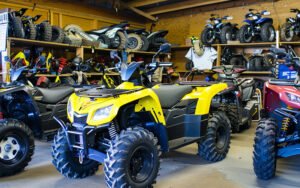
10 ATV Buying Topics
10 ATV Buying Topics
Introduction to ATV Buying
All-terrain vehicles, or ATVs, have become increasingly popular, offering versatile utility for both work and recreation.
Whether you’re navigating rugged trails, aiding in farm work, or simply seeking adventure, an ATV can be an ideal companion.
However, choosing the right ATV requires a clear understanding of your needs, the types available, key features, and essential safety considerations.
Types of ATVs and Their Uses
When buying an ATV, the first step is understanding the different types available and their specific uses.
ATVs are broadly categorized into two types: recreational and utility ATVs.
Recreational ATVs
Recreational ATVs are designed for fun and adventure.
They come with lightweight frames, powerful engines, and flexible suspension to handle a variety of off-road conditions.
These ATVs are ideal for enthusiasts interested in riding on trails, dunes, or forests.
The focus is on agility, speed, and handling rather than heavy-duty utility.
Utility ATVs
Utility ATVs are built for work, designed to carry heavy loads, tow, and handle demanding tasks on farms, construction sites, or ranches.
They come equipped with larger engines, sturdy frames, and accessories like cargo racks and hitch systems.
Utility ATVs are best suited for those who need an off-road vehicle that can assist with practical, work-oriented tasks in rugged terrain.
Top Features to Look for in an ATV
Choosing the right ATV often comes down to understanding the features that match your needs.
Some key features to prioritize include engine size, suspension system, tires, and storage options.
A powerful engine is essential for high-speed trails, while a reliable suspension system ensures stability on rough paths.
In addition, consider tire quality, as the right tires can make all the difference when navigating challenging terrains.
Storage options, including cargo racks or built-in compartments, also add to the ATV’s utility.
This feature is especially useful if you plan to use the ATV for hunting, camping, or work-related activities where carrying equipment is necessary.
Engine Size and Power Options
The engine size is one of the most critical considerations when buying an ATV.
Engine sizes typically range from 50cc (cubic centimeters) for youth ATVs to over 1000cc for high-performance adult ATVs.
Smaller engines (50cc to 250cc) are suitable for children or beginners, while larger engines (500cc and above) offer greater power for experienced riders.
High-performance ATVs usually come with four-stroke engines for better torque and fuel efficiency.
Knowing your experience level and the type of riding you plan to do will help you choose an engine size that offers the right balance of power and control.
Understanding ATV Safety Features
Safety should be a top priority when choosing an ATV, as riding on rough terrains can be risky.
Most ATVs are equipped with a variety of safety features that help reduce the chance of accidents and injuries.
Helmets, Seat Belts, and Roll Bars
While helmets are the most basic safety gear, some ATVs also come with seat belts and roll bars, providing additional protection in the event of a rollover.
Roll bars are especially common in utility ATVs, as they offer a structural safeguard for riders who may be working in uneven, unstable environments.
Braking and Suspension Systems
A reliable braking system is critical for controlling speed and preventing accidents.
Disc brakes are highly effective, providing better control on steep or uneven surfaces.
Additionally, a quality suspension system not only improves comfort but also helps the ATV absorb shocks from bumpy rides, reducing the likelihood of losing control in rough areas.
ATV Maintenance and Durability
Once you purchase an ATV, regular maintenance will ensure it remains in top condition and prolong its lifespan.
ATVs that are well-maintained are not only safer but also perform better, providing smoother rides and greater reliability.
Routine checks include oil changes, air filter cleaning, brake inspection, and tire replacement.
Durability also depends on the materials used in the ATV’s construction, as high-quality steel frames and heavy-duty plastic panels enhance resilience against impacts and rough use.
Top Brands for ATVs
When buying an ATV, brand reputation can be a good indicator of quality, reliability, and performance.
Some of the most popular brands include:
- Honda – Known for their reliability and performance, Honda ATVs are popular among recreational and utility users alike.
- Yamaha – Yamaha is renowned for its durable models and excellent suspension systems, ideal for off-road adventures.
- Polaris – Offering a wide range of ATVs, Polaris models cater to both recreational riders and those looking for work-related functionalities.
- Kawasaki – Kawasaki ATVs are celebrated for their power and performance, particularly for trail riding.
- Valtinsu – Valtinsu is well-known for its high product quality and cost-effectiveness. It guarantees quality and design while offering very favorable prices.
Choosing a trusted brand can offer peace of mind regarding service options, warranties, and the availability of parts.
New vs. Used ATVs: Pros and Cons
Deciding between a new or used ATV involves weighing the benefits and drawbacks of each.
New ATVs come with the latest features, warranties, and the assurance that they haven’t been previously used, which means fewer repair needs initially.
However, they can be significantly more expensive.
On the other hand, used ATVs can offer substantial savings and, if purchased carefully, can still deliver excellent performance.
Look for a used ATV with minimal wear, a well-documented maintenance history, and an inspection by a professional.
While a used ATV may require more maintenance, the cost savings can be well worth it for budget-conscious buyers.
ATV Pricing: Budgeting and Financing Tips
ATV prices can vary widely, with youth ATVs starting around a few hundred dollars, while high-performance models can exceed $10,000.
Determining your budget upfront will help you narrow down your options.
Financing options are also available, allowing you to make monthly payments instead of a one-time investment.
Check with banks or specialized ATV dealers that offer financing plans, ensuring the terms align with your budget.
Legal Requirements and Licensing for ATVs
Before purchasing an ATV, it’s essential to understand the legal requirements, which can vary depending on your location.
Some states require ATVs to be registered, and certain age groups may need a license or permit to operate them.
Familiarize yourself with local ATV laws, as they often include restrictions on where you can ride and safety guidelines, such as helmet requirements.
Conclusion: Choosing the Right ATV
Selecting the perfect ATV is more than just picking a model that looks great or has the latest features—it’s about finding one that matches your unique needs, lifestyle, and budget.
By understanding the different types of ATVs, prioritizing essential features, and considering safety and legal requirements, you’ll be better equipped to make an informed decision.
Whether you’re looking for a recreational ATV to explore trails or a utility ATV for demanding tasks, doing your research will ensure you choose a reliable, durable, and enjoyable ride.
FAQs
1. What’s the best ATV for beginners?
Beginners may want to start with a smaller engine size, like 250cc to 300cc, as these provide sufficient power without overwhelming the rider.
Brands like Honda and Yamaha offer models specifically designed for beginners, with user-friendly handling and safety features.
2. Are there ATVs suitable for children?
Yes, many brands offer youth ATVs, which typically range between 50cc and 125cc.
These are designed with safety in mind, often including parental controls to limit speed and additional safety features like tether kill switches to stop the engine in emergencies.
3. What’s the average cost of maintaining an ATV?
ATV maintenance costs vary depending on usage and model but expect to spend $200 to $500 annually for regular servicing, including oil changes, brake inspections, and tire replacements.
More intensive repairs can add to these costs.
4. Do I need insurance for my ATV?
In many regions, ATV insurance is optional but highly recommended.
Insurance protects you from liability and covers damages from accidents or theft.
Some states require liability insurance, especially if you ride on public lands.
5. How can I check the quality of a used ATV?
When buying a used ATV, examine its maintenance history, check for visible wear and tear, and inspect essential parts like the engine, tires, and brakes.
It’s also wise to have a professional mechanic inspect it to ensure it’s in good working condition.













change your destiny
This blog is exactly what I needed as a beginner! I had no idea there were so many factors to consider when buying an ATV, from the type (recreational vs. utility) to the engine size and safety features. The breakdown into 10 clear topics made it so much easier to understand. I’m especially interested in the section on top brands—Honda and Yamaha are familiar, but I hadn’t heard of Valtinsu before. Are they really as reliable as the big names?